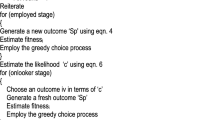Abstract
Intrusion detection system (IDS) is an essential cyber security tool which is used to detect abnormal activity on a network or a host. A general approach towards designing IDS models is to use classifiers as detection units. But a large feature space including noisy, redundant and irrelevant features often leads to low detection and high misclassification rates by the classifier. To address this drawback, the process of selecting most relevant key features for classification is highly important. The objective of this work is to optimize the process of feature selection in a way that improves the accuracy of the classifier. This paper presents an IDS model wherein an intelligent water drops (IWD) algorithm-based feature selection method is proposed. This method uses the IWD algorithm, a nature-inspired optimization algorithm for the feature subset selection along with support vector machine as a classifier for evaluation of the features selected. The experiments are conducted using KDD CUP’99 dataset, and the performance is compared with earlier designs. The experimental results show that the proposed model performs better in terms of higher detection rate, low false alarm rate and improved accuracy than the existing approaches.



Similar content being viewed by others
Explore related subjects
Discover the latest articles, news and stories from top researchers in related subjects.References
Aghdam MH, Kabiri P (2016) Feature selection for intrusion detection system using ant colony optimization. Int J Netw Secur 18(3):420–432
Alijla BO, Peng LC, Khader AT, Al-Betar MA (2013) Intelligent water drops algorithm for rough set feature selection. In: Selamat A et al (eds) ACIIDS 2013, Part II, LNAI 7803. Springer, Berlin, pp 356–365
Aslahi-Shahri BM, Rahmani R, Chizari M, Maralani A, Eslami M, Golkar MJ, Ebrahim A (2015) A hybrid method consisting of GA and SVM for intrusion detection system. Neural Comput Appl. doi:10.1007/s00521-015-1964-2
Chen R-C, Cheng K-F, Hsieh C-F (2009) Using rough set and support vector machine for network intrusion detection. Int J Netw Secur Appl 1(1):1–13
Cortes C, Vapnik V (1995) Support-Vector Networks. Mach Learn 20(3):273–297. doi:10.1023/A:1022627411411
Eid HF, Darwish A, Hassanien AE, Abraham A (2010) Principle components analysis and support vector machine based intrusion detection system. In: IEEE international conference on intelligent systems design and applications, 978-1-4244-8136-1/10
El-Khatib K (2010) Impact of feature reduction on the efficiency of wireless intrusion detection systems. IEEE Trans Parallel Distrib Syst 21(8):1143–1149
Guo C, Zhou Y, Ping Y, Zhang Z, Liu G, Yang Y (2013) A distance sum-based hybrid method for intrusion detection. Appl Intell 40:178–188
Huang C-L, Wang C-J (2006) A GA-based feature selection and parameters optimization for support vector machines. Expert Syst Appl 31:231–240. doi:10.1016/j.eswa.2005.09.024
Iglesias F, Zseby T (2015) Analysis of network traffic features for anomaly detection. Mach Learn 101:59–84. doi:10.1007/s10994-014-5473-9
Khan L, Awad M, Thuraisingham B (2007) A new intrusion detection system using support vector machines and hierarchical clustering. VLDB J 16:507–521
Kuang F, Zhang S, Jin Z, Xu W (2015) A novel SVM by combining kernel principal component analysis and improved chaotic particle swarm optimization for intrusion detection. Soft Comput 19:1187. doi:10.1007/s00500-014-1332-7
Pozi MSM, Sulaiman MN, Mustapha N, Perumal T (2015) Improving anomalous rare attack detection rate for intrusion detection system using support vector machine and genetic programming. Neural Process Lett. doi:10.1007/s11063-015-9457-y
Shah-Hosseini H (2009) Optimization with the nature-inspired intelligent water drops algorithm. In: dos Santos WP (ed) Evolutionary computation. I-Tech, Vienna, p 572. ISBN 978-953-307-008-7
Singh S, Silakari S (2009) A survey of cyber attack detection systems. Int J Comput Sci Netw Secur 9(5):1–10
Suthaharan S, Panchagnula T (2012) Feature selection with data cleaning for intrusion detection system. Relevance 978-1-4673-1375-9/12/$31.00 2012 IEEE
Tsai C-F, Hsu Y-F, Lin C-Y, Lin W-Y (2009) Intrusion detection by machine learning: a review. Expert Syst Appl 36(10):11994–12000
Author information
Authors and Affiliations
Corresponding author
Ethics declarations
Conflict of interest
The authors declare that they have no conflict of interest.
Ethical approval
This article does not contain any studies with human participants or animals performed by any of the authors.
Additional information
Communicated by V. Loia.
Rights and permissions
About this article
Cite this article
Acharya, N., Singh, S. An IWD-based feature selection method for intrusion detection system. Soft Comput 22, 4407–4416 (2018). https://doi.org/10.1007/s00500-017-2635-2
Published:
Issue Date:
DOI: https://doi.org/10.1007/s00500-017-2635-2




